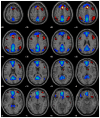Decreased default mode neural modulation with age in schizophrenia
- PMID: 20808138
- PMCID: PMC2946487
- DOI: 10.1097/JGP.0b013e3181e9b9d9
Decreased default mode neural modulation with age in schizophrenia
Abstract
Objective: Previous studies have shown that patients with schizophrenia have less modulation of the task-positive and default mode neural networks during novelty detection. The diminished modulation may be interpreted as less functional activation of the task-positive network and less functional deactivation of the default mode network. The relationship between network modulation and age has not been assessed in patients with a long duration of illness.
Method: Seventeen patients with schizophrenia (age range, from 34 to 60 years) with minimum disorder duration of 15 years and 28 demographically similar comparison subjects (age range, from 36 to 58 years) from the Mind Clinical Imaging Consortium database completed the auditory oddball discrimination task. Independent component analysis identified temporally cohesive but spatially distributed neural networks.
Results: Group membership (F[1, 41] = 7.17, p = 0.011) and the interaction of group and age (F[1, 41] = 6.92, p = 0.012) affected the modulation of the anterior default mode network. Duration of illness was also significantly related to the modulation of the anterior default mode network (t[2, 15] = 2.24, p <0.042). These results were selective for the anterior default mode network and were not replicated with the posterior default mode network.
Conclusions: These findings show evidence of changes in the temporal modulation of the anterior default mode network with age and duration of illness in patients with schizophrenia. The loss of negative modulation of the anterior default mode network suggests that neural functions in schizophrenia may not be "static" later in the disease course.
Figures



References
-
- Kurtz MM. Neurocognitive impairment across the lifespan in schizophrenia: an update. Schizophr Res. 2005;74(1):15–26. - PubMed
-
- Lieberman JA, Perkins D, Belger A, Chakos M, Jarskog F, Boteva K, Gilmore J. The early stages of schizophrenia: speculations on pathogenesis, pathophysiology, and therapeutic approaches. Biol Psychiatry. 2001;50(11):884–97. - PubMed
-
- Magliero A, Bashore TR, Coles MG, Donchin E. On the dependence of P300 latency on stimulus evaluation processes. Psychophysiology. 1984;21(2):171–86. - PubMed
-
- Polich J, Corey-Bloom J. Alzheimer’s disease and P300: review and evaluation of task and modality. Curr Alzheimer Res. 2005;2(5):515–25. - PubMed
MeSH terms
Grants and funding
LinkOut - more resources
Full Text Sources
Medical

